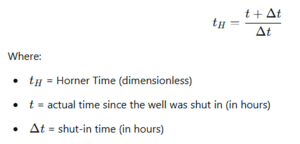What is Horner Time?
 Horner Time refers to a technique used in reservoir engineering to analyze pressure buildup data from a well test, particularly in a situation where the well is shut in after being produced or flowed. It is named after the engineer J. R. Horner, who developed this method in the 1950s. Horner Time is an important concept for interpreting pressure transient tests, which help assess the productivity and behavior of the reservoir.
Horner Time refers to a technique used in reservoir engineering to analyze pressure buildup data from a well test, particularly in a situation where the well is shut in after being produced or flowed. It is named after the engineer J. R. Horner, who developed this method in the 1950s. Horner Time is an important concept for interpreting pressure transient tests, which help assess the productivity and behavior of the reservoir.
How Horner Time Works
Horner Time is applied to build-up tests, which occur after the well has been flowing for some time and is then shut in to monitor how pressure increases back to equilibrium over a period of time. The test helps determine the reservoir properties, such as permeability, skin factor, and reservoir pressure. The Horner Plot is a graphical representation of pressure vs. Horner Time, where Horner Time is used as the time axis.Formula for Horner Time
The Horner Time is calculated as:
Application of Horner Time
- Analyzing Pressure Data: When a well is shut in after production, pressure data is recorded over time. The pressure increase is plotted against the Horner Time, where the Horner Time accounts for the pressure response over different periods. This allows engineers to analyze the rate at which the pressure recovers and to estimate reservoir properties like permeability and reservoir pressure.
- Pressure Transient Analysis: The Horner method helps to convert pressure buildup data into a more interpretable form. By plotting pressure on the y-axis and Horner Time on the x-axis, you can obtain a straight line on the graph, which is useful for estimating reservoir parameters.
- Estimating Reservoir Properties: Using the Horner Plot, engineers can estimate:
- Reservoir permeability: The rate at which fluids can flow through the reservoir rock.
- Skin factor: A measure of damage or changes in permeability near the wellbore.
- Reservoir pressure: The pressure at the initial state of the reservoir before any production.
- Decline Curve Fitting: In some cases, Horner Time can be used in decline curve analysis for forecasting production decline in reservoirs, helping operators make better decisions regarding well stimulation, production strategy, and reservoir management.
 In Summary:
In Summary:
- Horner Time is a time transformation used in reservoir engineering to analyze pressure buildup data during a well test.
- It allows engineers to apply pressure transient analysis to evaluate important reservoir parameters like permeability, skin factor, and initial pressure.
- The method involves plotting pressure versus Horner Time and fitting the data to determine reservoir characteristics.
